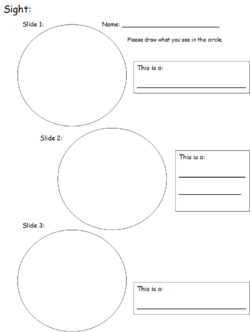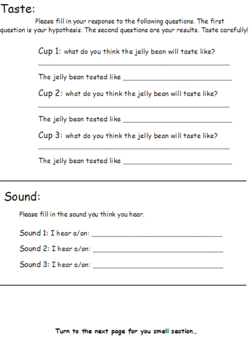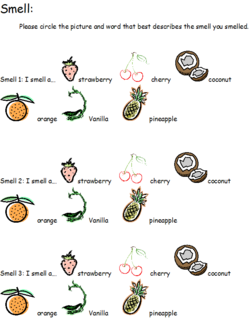Exploring the Five Senses
| Instant wiki maker | Making handouts | Editing tips |
Contents
- 1 Third Grader, Third Grader, What do you Sense?
- 1.1 Student worthiness
- 1.2 Primary biological content area covered
- 1.3 Materials
- 1.4 Handouts
- 1.5 Description of activity
- 1.6 Lesson plan
- 1.7 Potential pitfalls
- 1.8 Math connections
- 1.9 Literature connections
- 1.10 Connections to educational standards
- 1.11 Next steps
- 1.12 Reflection
- 1.13 Citations and links
Biology In Elementary Schools is a Saint Michael's College student project from a course that ran between 2007 and 2010 and fully described in this book chapter. The student-created resources have been preserved here for posterity. Link under 'toolbox' for printer-friendly versions of the exercises. Click on handouts to print full resolution versions. Please see Wikieducator's disclaimer, our safety statement, and the Creative Commons licensing in English and in legalese.
Third Grader, Third Grader, What do you Sense?
Student worthiness
Tried at least once. It worked very well:)
Primary biological content area covered
Recognizing and using the five senses.
Materials
Teacher Use
- Slides
- Microscopes
- Touch boxes
- Paper cups
- Sounds
- Cassette player, CD player, or computer
- Headphones
- Popsicle sticks
- Different essences (vanilla, strawberry, coconut)
- Jelly beans
- Worksheets (link found under Handouts)
Student Group
- Not applicable
Individual Student
- Pencil
- Imagination
Handouts
Description of activity
There will be five stations set up and each student will travel around to use all of their senses. At each station there will be a way for them to hypothesize and record their results.
Lesson plan
This lesson requires quite a bit of set-up. Before the students enter the classroom there should be five stations set up around the room. To start tell the children that they will be learning about the five senses today and how they help us survive. Introduction: You can start by telling the children that they are exploring with their five senses and then read a book relating to that. After this follow the lesson plan below.
- First you must divide the class into five groups. This can be done in pairs or in bigger groups if necessary. Each group or pair will travel around to five stations; smell, sight, hearing, touch, and taste. At each station they will use their handouts to record their observations.
- After this is done send your groups around the class room to explore the stations. There should be about five minutes for each station. You can signal the switch with a bell, a clap or your normal attention grabbing sound.
Each station will be equipped with the materials you set out before hand.
- At the SMELL station, there will be three separate cups filled with vanilla extract, coconut extract, and strawberry extract. During set-up you must submerge the popsicle stick into the cup. Let the popsicle stick soak and catch the scent so when taken out, students can smell the scent. The cups will be labeled and the student is to take one stick out at a time and smell it. He or she must then circle the smell that they are sensing on their worksheet. Encourage your students to save these worksheets, that way you'll be able to collect and graph the data.
- At the SIGHT station, students will examine through a microscope three different images. Slides can include, salt, sugar, hair, flower pedals, etc. After students examine each slide they will draw what they see in the appropriate circle on their 'sight' handout. Below their drawing he or she will label what they think the object is in the space provided. This handout will be in the packet given to the students at the start of the exercise.
- At the HEARING or SOUND station, students will put on head phones and listen to three separate and distinct sounds. After each sound have the students record what they have heard. This will be a fill in the blank style sheet. (see handout section) This worksheet can also be found in the packet.
- At the TOUCH station, students will reach inside three separate touch boxes and use their sense of feeling to guess the object inside the box. The objects used in our touch boxes were cotton balls, two tennis balls and a large seashell. The recording of data for this activity will be done on a large graph. Each student will receive an ink-jet label the student is to write their idea of what there touching and add it to the 'x' axis of the graph, they then will place a circular sticker above their idea. The stickers will map the 'y' axis. When each student has visited the station they will have a bar graph of all the things they thought they touched. At the very end of the experiment the students will be told what they touched.
- At the TASTE station, students will get to taste three different jelly bean flavors. Students will first make a prediction based on color of the bean what flavor they think the bean will be. Afterwards they will write down what they think the flavor of the jelly bean is. The worksheet promotes the hypothesis and the conclusion.
Assessment: The students will demonstrate their knowledge by filling out the graphs and the worksheets provided. They will also use a diagram illustrating each particular sense and the correlating station. This will allow them to identify where the sense is that they are using.
Potential pitfalls
- One should be sure that there are no student allergies.
- There should also be someone helping to run the sight station. Drawing what you see in the microscope can be tricky.
Math connections
One math connection has already been provided through the bar graph that the students made at the touch station. All stations can be easily adapted to involved a graphing or collection of data.
Literature connections
Literary activity exploring the senses Use this link to find another way to incorporate senses into the curriculum.
Connections to educational standards
VT Standard: Scientific Inquiry GLE: S(3-4):2: Students demonstrate their understanding of the scientific method by predicting and hypothesizing.GLE: S(3-4):4: Students demonstrate their ability to represent data collected in a graph format; following a detailed plan of investigation; recording data and observations during the experiment GLE: S(3-4):5:Students demonstrate their ability to represent data by organizing a collection of data into a table or a graph template. Human Body GLE: S(3-4):41: Students demonstrate their understanding by showing how external body structures help them survive; relating the external to the internal body structures.
Next steps
This activity can be embedded in many curriculums. The one I feel would be most interesting and engaging for the students would be an activity surrounding disabilities or challenges that people may face. This will allow them to empathize with people who do not have the use of one sense. These students can also use the literacy activity presented in this page, this would also connect to the larger unit of disabilities. This exercise can also be brought into a math lesson, the teacher can take the bar graph and use it to demonstrate the proper way to label and fill out a bar graph. Lastly, this can be used to make a larger writing activity. Each group can write up a 'lab report' of what happened at each station. Listing the materials, what they did, how they made their hypothesis and so forth. The teacher could then post that on a bulletin board and make it a 'class lab report.' This could be a great way at the beginning of the year to demonstrate the proper format of a 3rd grade lab report.
Reflection
Celia- This activity was certainly a learning experience. We walked into the classroom with a lot of materials. We took a while to get set up but I think that the students appreciated the time and the variety of activities. The sight station proved to be the hardest because drawing what you see in the microscope and then making a prediction about that is an acquired skill. I would suggest that the teacher at that station encourages active thought. We received a lot of 'I dunno's'. This made it slightly difficult, because we then had to suggest things that it could be and that sparked interest. This station was far more guided than the others. The students loved the touch boxes and the jellybeans were a hit. The handout of the activity sheet provided enough structure and enough freedom for these students to use their scientific brains. I enjoyed watching and engaging these children in using many intelligences. This is a lab that I would definitely bring to my classroom. It's set-up intensive but the reward is great.
Montana- This activity that we brought to Lawrence Barnes was a project to set up and to get going, but once on the ball was a huge hit and very successful in my eyes. Like Celia said the sight was difficult to get through. Students needed the extra push at that station for both answers and time constraint. This activity once set up runs super smoothly, but a little more time than 25 minutes would have been ideal so that the students had the full experience and chance to make their guesses without being rushed, seeing as the whole point was to build a hypothesis and prove it right or wrong. The rest of the four station were much easier to get through and the students really dove in and had a good time with it. I truly believe that skills and knowledge was learned during this activity and I would most certainly use this in the future in my own classroom after seeing the success and the positive attitudes towards our station. Once the materials are present and the lesson set-up it is a very quick and easy way to explore sight, sound, taste, touch, and smell.
Lindsay- This activity was truly a great way to explore the five senses. I do agree with my group members that the sight station was the hardest for most students. Some could not see into the microscope, and others found it difficult to predict what the slides could be, however with a little help and suggestions the students were able to make a guess. Also, by showing the students the slides not under the microscope, they were also able to predict what they thought the slide could be. The rest of the stations, though timely to set up, were more easier for the students to grasp. Overall, I feel as though the students really enjoyed this activity and it is great to use in the classroom.
Citations and links
- This is the site where we adapted our teaching idea from.
- This is the site where we found our sounds from. We used, a horse, the ocean and laughter. All images are copyright free and free of charge:) This is a great resource.



